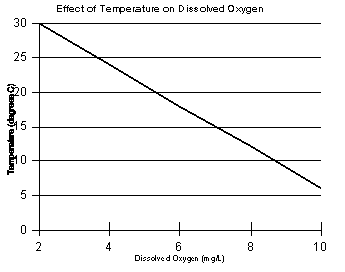
In addition to having its own toxic effect, temperature affects the solubility and, in turn, the toxicity of many other parameters. Generally the solubility of solids increases with increasing temperature, while gases tend to be more soluble in cold water. Temperature is a factor in determining allowable limits for other parameters such as ammonia.
Methodology: The simplest field method is to use a thermometer; however, electronic thermal sensing devices are available with continuous read-outs.
Environmental Impact: The Federal Water Pollution Control Administration (1967) referred to temperature as "a catalyst, a depressant, an activator, a restrictor, a stimulator, a controller, a killer, one of the most important and most influential water quality characteristics to life in water."
An important physical relationship exists between the amount of dissolved oxygen in a body of water and its temperature. Simply put, "the warmer the water, the less dissolved oxygen, and vice versa." Figure 2 shows the relationship.

For this reason, heat or "thermal pollution" may be a problem, especially in shallow slow-moving streams, embayments, or pools which can get very warm in mid-summer. Most fish simply can't stand warm water and/or low levels of dissolved oxygen. Thermal pollution may also result when industries--especially electrical power companies--release the water used for cooling their machines into waterways. Water temperatures, even miles from the release points, may rise dramatically. The result may be dead fish, fish eggs that won't hatch or a total change in the fish population as warm water varieties replace the original trout or other cold water fish. As you might guess, the warm waters near power plants attract lots of "rough" fish which can tolerate the higher temperatures and lower levels of oxygen.
Reproductive events are perhaps the most thermally-restricted of all life phases. Even natural short-term temperature fluctuations appear to cause reduced reproduction of fish and invertebrates. Adults and juveniles are much better able to withstand fluctuations in temperature. Furthermore, juvenile and adult fish usually thermoregulate behaviorally by moving to water having temperatures closest to their thermal preference. This provides a thermal environment which approximates the optimal temperature for many physiological functions, including growth. As a consequence, fishes usually are attracted to heated water during the fall, winter and spring. Avoidance will occur in summer as water temperature exceeds the preferred temperature. Table II shows the highest temperature at which maximum growth can occur, the optimum spawning (egg laying) temperature, and the optimum temperature for incubation and hatching of several species of fish.
(Centigrade and Fahrenheit)
| Species | Growth1C (F) | Spawning2 C (F) | Embryo Survival3 C (F) |
| Bluegill | 32 (90) | 25 (77) | 34 (93) |
| Carp | ----- | 21 (70) | 33 (91) |
| Channel catfish | 32 (90) | 27 (81) | 20 (84) |
| Largemouth bass | 32 (90) | 21 (70) | 27 (81) |
| Rainbow trout | 19 (66) | 9 (48) | 13 (55) |
| White crappie | 28 (82) | 18 (64) | 23 (73) |
1Calculated according to the equation (using optimum temperature for growth) maximum weekly average temperature for growth = optimum temperature + (ultimate incipient lethal temperature - optimum temperature).
2 The optimum or mean of the range of spawning temperature reported for the species (ERL-Duluth, 1976).
3 The upper temperature for successful incubation and hatching reported for the species (ERL-Duluth, 1976).
Criteria: Water quality criteria for temperature are based on the time of the year. For aquatic life the temperature should not exceed 25C (77F) during the latter half of October and the average temperature during that time period should be no higher than 22.2C (72 F).